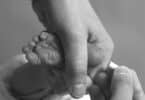Imagine a newborn baby, seemingly healthy, nestled in their parents’ arms. Everything seems perfect—until, days later, a life-threatening illness known as neonatal sepsis strikes. Sepsis is a condition where the body’s response to infection causes organ damage, and in newborns, it often manifests subtly before spiraling into a critical emergency.
For decades, doctors have relied on clinical signs and delayed lab results to diagnose neonatal sepsis. But what if we could predict this deadly condition before a baby even shows symptoms? A new study, led by researchers at UBC and Simon Fraser University (SFU) in collaboration with the Medical Research Council (MRC) Unit The Gambia, has revealed a possibility: the answer might already be written in the baby’s genes at birth.
Neonatal sepsis affects approximately 2-3 out of every 100 live births worldwide, with much higher rates in low-income countries. It’s particularly dangerous for newborns because their immune systems are still developing. The condition can cause respiratory distress, poor feeding, and a host of non-specific symptoms that often overlap with less severe issues, delaying critical treatment.
Despite its urgency, diagnosing neonatal sepsis has always been challenging. The current “gold standard” involves blood cultures to identify bacteria, but these tests can take days. Meanwhile, the baby might already be in critical condition. This delay forces doctors into a tough spot: should they administer antibiotics preemptively, risking side effects and antibiotic resistance, or wait and risk under-treating the baby?
In a study led by researchers from institutions across the globe, including the Gambia, Canada, and the United States, scientists identified a “gene signature” that could predict neonatal sepsis at birth—even before any symptoms appear. This study focused on 720 healthy, full-term newborns, including 21 who later developed sepsis within the first 28 days of life.
The researchers analyzed the newborns’ blood samples at birth and identified four genes—HSPH1, BORA, NCAPG2, and PRIM1—that behaved differently in babies who later developed early-onset sepsis (EOS, occurring within the first week of life). This gene signature showed remarkable accuracy, with a sensitivity of 93% and specificity of 92% in distinguishing high-risk newborns from healthy ones.
What Does a Gene Signature Mean?
A “gene signature” is like a molecular fingerprint. It’s a combination of specific genes that, when analyzed together, provide critical information about an individual’s health or risk of disease. In this case, the four identified genes are involved in processes like cell division and stress responses.
The presence of these altered gene patterns in babies who appeared healthy at birth suggests that their bodies were already under stress or predisposed to developing sepsis, even though no visible signs were present.
Why This Matters:
This discovery could be a game-changer in neonatal care, offering several potential benefits:
- Early Intervention: Doctors could identify at-risk newborns immediately after birth, even before symptoms develop, allowing for targeted monitoring and early treatment.
- Reduced Antibiotic Use: By pinpointing which babies are truly at risk, doctors could avoid unnecessary antibiotic treatments, reducing the risks of side effects and antibiotic resistance.
- Improved Outcomes: Early detection means faster intervention, potentially reducing the long-term complications associated with neonatal sepsis, such as developmental delays and organ damage.
A Closer Look at the Genes
Each of the four genes plays a unique role:
- HSPH1: This gene is part of the heat shock protein family, which helps protect cells from stress. In babies who developed sepsis, this gene was unusually active at birth, possibly signaling early cellular stress.
- BORA and NCAPG2: These genes are involved in cell division and were also highly active in high-risk newborns, suggesting a disruption in normal cellular processes.
- PRIM1: This gene, essential for DNA replication, was another key player in the signature, hinting at early changes in how cells prepare for growth and repair.
What the Future Holds
While this study represents a major breakthrough, more research is needed before gene signature testing becomes a standard part of newborn care. Larger studies across diverse populations will be needed to ensure the findings are universally applicable. Additionally, developing affordable and accessible testing methods will be essential, particularly for use in low-income countries where neonatal sepsis is most prevalent.
Excitingly, new technologies are already being developed to analyze gene signatures quickly and efficiently. These tools could one day become routine in delivery rooms, offering every newborn the best possible start in life.
Challenges and Ethical Considerations
As with any medical breakthrough, this innovation comes with challenges. Collecting blood from healthy-appearing newborns can be ethically complex, as it involves an invasive procedure without immediate therapeutic benefit. Additionally, the cost and accessibility of gene testing might create disparities between high- and low-income healthcare systems.
However, the potential to save lives and improve outcomes makes these challenges worth addressing. With the right investments in research, education, and technology, this discovery could revolutionize neonatal care worldwide.
Related Articles:







